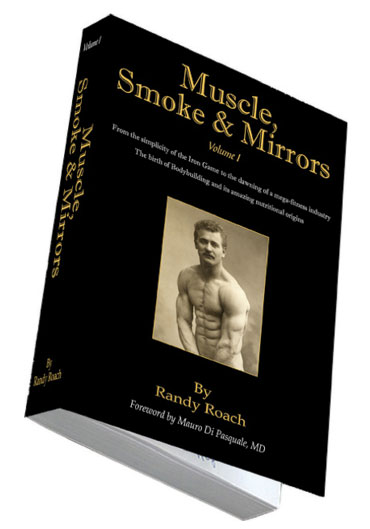 Spanish-American philosopher George Santayana famously warned, “Those who cannot remember the past are condemned to repeat it.” Publication of volume I of Randy Roach’s three-volume Muscle, Smoke and Mirrors should dispel the curse of historical ignorance once and for all. Be prepared: Once you start reading, the 566-page book may well take over your life until you finish it. Then you’ll be hungry for the next two installments. You’ll come away far wiser about the forces, politics and ideas that still shape bodybuilding.
Spanish-American philosopher George Santayana famously warned, “Those who cannot remember the past are condemned to repeat it.” Publication of volume I of Randy Roach’s three-volume Muscle, Smoke and Mirrors should dispel the curse of historical ignorance once and for all. Be prepared: Once you start reading, the 566-page book may well take over your life until you finish it. Then you’ll be hungry for the next two installments. You’ll come away far wiser about the forces, politics and ideas that still shape bodybuilding.
Roach is an amazing storyteller and detective, writing with a passion that engages the reader’s imagination. His work is far more than a recitation of names and dates. Beginning with the gyms, training methods and personalities of the second half of the 19th century, he guides us through the development of physical culture down through the catalytic 1960s. No story of strength and muscle building could be told without a discussion of the various camps—often at odds with each other—regarding equipment, training methods and nutrition.
In 1931, what was to have been Bernarr Macfadden’s ninth edition of his Encyclopedia of Physical Culture became The Encyclopedia of Health. Nevertheless, through the 1960s, telephone directories listed gyms under the heading Physical Culture.
The term “physical culture” enjoyed a long and esteemed use and included what today would be called natural bodybuilding for fitness and health. Bodybuilding magazines were physical culture magazines until steroids took root in the 1960s. Of the physical culture magazines, only one remains today: IRON MAN, published for 50 years by Peary and Mabel Rader, taken over by John Balik in 1986.
Roach’s title captures the direction of his book: While bodybuilders achieve exceptional physical development through discipline, diet and hard work, an immense industry promotes the game with a lot of smoke and mirrors. The open warfare between “the Father of American Weightlifting” (Bob Hoffman and his York Barbell Company) and “the King of Bodybuilders” (Joe Weider and his brother Ben) threads through the last half of the book. The wise voices of moderation and genuine physical culture, however, were found in the Raders’ Iron Man, the sole open forum for exchange of training and dietary information. Only Iron Man would provide Arthur Jones with space to inform the world of his development of Nautilus training principles and equipment.
The Weider-Hoffman battles took shape in campaigns of disinformation. The victims were the athletes who depended on their publications for accurate training information.
Hoffman’s York Barbell Company sponsored his York Barbell Club. Hoffman did his best to promote the notion that you should train for strength and that size would follow. His interests were in fielding winning American Olympic lifting teams. He had little real use for bodybuilders or powerlifters—so much so that he used his influence to keep powerlifting from becoming an AAU-sanctioned sport. Hoffman’s dominating influence shaped early exercise physiology’s adherence to strength training over density training for pump. Weider, on the other hand, reported on the prize-winning training practices of many a successful bodybuilder making use of higher reps.
In the early 1950s Irwin Johnson (later famous as Rheo H. Blair) introduced the first commercially manufactured protein powder, a very crude soy product. Hoffman sold him advertising space at first, but as he noted sales volumes for protein, he developed his crude Hoffman’s Hi-Proteen and cut Johnson out. Before that barbell magazines sold barbells. Barbells don’t bring repeat sales, but protein supplements soon became a thriving business. By the 1960s Blair brought out his milk-and-egg protein, which was soon the hit of Muscle Beach and advertised only in Iron Man.
Protein products redirected bodybuilding. A healthful diet of nutrient-dense foods was no longer quite enough. You needed regular use of supplements to look like Mr. America. By the early 1960s York had added another must-have, must-do product: the power rack for isometric and isometronic exercise. York Olympic lifters evidenced incredible increases in strength in a very short time using the racks. Several York members became big, powerful physique contest winners using the rack. Both Hoffman and Weider offered newer, more refined protein products for building bigger bodybuilders.
More smoke and mirrors! York helped Dr. John Zeigler develop Dianabol, the first oral steroid and probably the most widely used performance-enhancing drug in 20th century sports. Word quickly spread about the secret behind the power rack and protein.
Muscle, Smoke and Mirrors brings to life the drive for fitness, health, longevity and athleticism that is at the core of good living. The bigger story is of dedicated athletes, equipment inventors, nutritional breakthroughs and success stories based on clean living. The heroes are persons we all benefit from knowing about: Armand Tanny, Vince Gironda, former Mr. America/Mr. Universe Bob Gajda, Peary and Mabel Rader, John Balik and Irvin Johnson. Muscle, Smoke and Mirrors exposes the darker moments of our sport’s heritage, yet it revalues physical culture as our real heritage.
Editor’s note: Muscle, Smoke and Mirrors can be purchased at www.randyroach.ca




















You must be logged in to post a comment Login